哺乳动物特征【英文】
哺乳动物介绍 英文
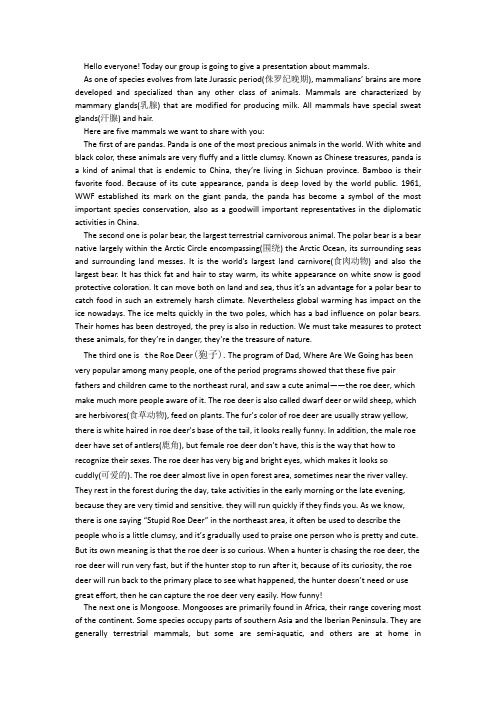
Hello everyone! Today our group is going to give a presentation about mammals.As one of species evolves from late Jurassic period(侏罗纪晚期), mammalians’ brains are more developed and specialized than any other class of animals. Mammals are characterized by mammary glands(乳腺) that are modified for producing milk. All mammals have special sweat glands(汗腺) and hair.Here are five mammals we want to share with you:The first of are pandas. Panda is one of the most precious animals in the world. With white and black color, these animals are very fluffy and a little clumsy. Known as Chinese treasures, panda is a kind of animal that is endemic to China, they’re living in Sichuan province. Bamboo is their favorite food. Because of its cute appearance, panda is deep loved by the world public. 1961, WWF established its mark on the giant panda, the panda has become a symbol of the most important species conservation, also as a goodwill important representatives in the diplomatic activities in China.The second one is polar bear, the largest terrestrial carnivorous animal. The polar bear is a bear native largely within the Arctic Circle encompassing(围绕) the Arctic Ocean, its surrounding seas and surrounding land messes. It is the world’s largest land carnivore(食肉动物) and also the largest bear. It has thick fat and hair to stay warm, its white appearance on white snow is good protective coloration. It can move both on land and sea, thus it’s an advantage for a polar bear to catch food in such an extremely harsh climate. Nevertheless global warming has impact on the ice nowadays. The ice melts quickly in the two poles, which has a bad influence on polar bears. Their homes has been destroyed, the prey is also in reduction. We must take measures to protect these animals, for they’re in danger, they’re the treasure of nature.The third one is t he Roe Deer(狍子).The program of Dad, Where Are We Going has been very popular among many people, one of the period programs showed that these five pair fathers and children came to the northeast rural, and saw a cute animal——the roe deer, which make much more people aware of it. The roe deer is also called dwarf deer or wild sheep, which are herbivores(食草动物), feed on plants. The fur’s color of roe deer are usually straw yellow, there is white h aired in roe deer’s base of the tail, it looks really funny. In addition, the male roe deer have set of antlers(鹿角), but female roe deer don’t have, this is the way that how to recognize their sexes. The roe deer has very big and bright eyes, which makes it looks socuddly(可爱的). The roe deer almost live in open forest area, sometimes near the river valley. They rest in the forest during the day, take activities in the early morning or the late evening, because they are very timid and sensitive. they will run quickly if they finds you. As we know, there is one saying “Stupid Roe Deer” in the northeast area, it often be used to describe the people who is a little clumsy, and it’s gradually used to praise one person who is pretty and cute. But its own meaning is that the roe deer is so curious. When a hunter is chasing the roe deer, the roe deer will run very fast, but if the hunter stop to run after it, because of its curiosity, the roe deer will run back to the primary place to see what happened, the hunter do esn’t need or use great effort, then he can capture the roe deer very easily. How funny!The next one is Mongoose. Mongooses are primarily found in Africa, their range covering most of the continent. Some species occupy parts of southern Asia and the Iberian Peninsula. They are generally terrestrial mammals, but some are semi-aquatic, and others are at home inthe treetops. They normally have brown or gray fur, and a number of species sport striped(有条纹的) coats or ringed tails. Mongooses live in burrows(地洞) , feeding on small animals such as birds, frogs, insects, and worms. Some species supplement their diet with fruits, nuts, and seeds. Creative hunters, they are known to break open bird eggs by throwing them with their forepaws toward a solid object. Today effort has been done to control the number of this animal. As mongooses threaten the survival of various native species, particularly birds. However, in their natural environments, mongooses are currently threatened themselves due to habitat loss.The last one is sloth. Sloths are extremely slow-moving mammals found in the rainforest of Central and South America. There are two species of sloths: two-toed and three-toed. Most sloths are about the size of a small dog and they have short, flat heads. Their hair is grayish brown but, at times they look grey-green in color because they move so slowly that tiny algae grow all over their coats. Some sloths stay in the same tree for years. Their huge hooked claws and long arms allow them to spend most of their time hanging upside-down from trees. Since they have a slow metabolism(新陈代谢), they need very little food. They feed on fruit, leaves, buds, and young twigs(细枝). Sloths also sleep upside-down for up to 18 hours at a time. Mothers also give birth to babies upside-down. Babies cling to their mothers until they are able to take care of themselves. That’s all. Thank you!。
动物学英语词汇

动物学英语词汇动物学英语词汇1. species 种类 n.2. degenerate 退化3. breed 物种,繁殖 n.v.4. food chain 食物链5. mammal 哺乳动物n.6. wild animal 野生动物7. living creature 生物8. mature 成熟a. v.9. immature 不成熟的.10. habitat 栖息地n.11. inhabit 栖息于,居住在12. evolve 进化v.13. evolution 进化14. instinct 本能n.15. feature 特点16. abilitycapacity 能力17. reproduction 繁殖n.18. appetite 食欲n.19. digestion 消化n.20. offspring/ descendent 后代n.21. grub 幼兽n.22. cub 幼兽23. predator 掠夺者n.24. prey 被掠夺者n.25. migrate--migration 迁徙26. aggression 侵略n.27. hatch 孵化v.28. hibernation 冬眠n.29. chew 咀嚼v.30. biological diversity 生物多样性31. visual and acoustic faculty 视觉和听觉能力32. sense 感官33. hormone 荷尔蒙34. intelligence 智慧35. emotion 情感36. joint 关节37. limb 四肢38. cognitionrecognition 认知,再认知39. muscle 肌肉40. nerve 神经41. organ 器官42. vulnerable 易受伤害的43. mate 交配伙伴44. gene 基因45. insect 昆虫46. aquaria 水族馆47. marine 海洋的48. life span 寿命49. life expectancy 寿命50. fur 皮毛。
哺乳动物的繁殖介绍【英文】

pengel@
1
Overview
• Characteristics of Mammals • Types of Mammalian Reproduction
– Monotremes – Marsupials – Placental
• Summary
/mammal/monotreme.html
pengel@
5
Marsupials
• Pouched Mammals • Live birth, but young are born underdeveloped • Crawl from birth canal and latch onto nipple, continue to develop in pouch. • Special structures
/OLD_WWW/opossuminfo.html
pengel@
10
Quick Review
• Placental mammals bear live young • Young develop in uterus • Long gestation period • Nourished by milk through nipples
– Nipples – Pouch
Red Kangaroo. Photo by Gerald and Buff Corsi, © 2002 California Academy of Sciences.
Wombat. Photo © 2005 Sharon Chester
• Include Kangaroos, koalas, wombats,
pengel@11来自• Mammals use sexual reproduction to produce offspring.
熊猫的特征和外貌描写英语作文

熊猫的特征和外貌描写英语作文英文回答:The giant panda (Ailuropoda melanoleuca) is a large mammal native to central China. It is easily recognizable by its distinctive black and white coat. The panda has a round body, short legs, and a large head with prominent ears. Its fur is dense and wooly, with a black coat on its back, ears, legs, and around its eyes. The rest of its fur is white.The average adult panda weighs between 75 and 150 kilograms (165 and 330 pounds). Males are typically larger than females. The panda's diet consists mainly of bamboo, but it will also eat other plants, including fruits, vegetables, and insects.Pandas are solitary animals that spend most of their time alone. They are active during the day and spend most of their time sleeping or eating. Pandas are good climbersand can spend a lot of time in trees.The panda is an endangered species, with only about1,864 individuals remaining in the wild. The main threatsto the panda are habitat loss and fragmentation, poaching, and climate change.中文回答:熊猫的特征和外貌描写。
介绍一下羊的样子英语作文
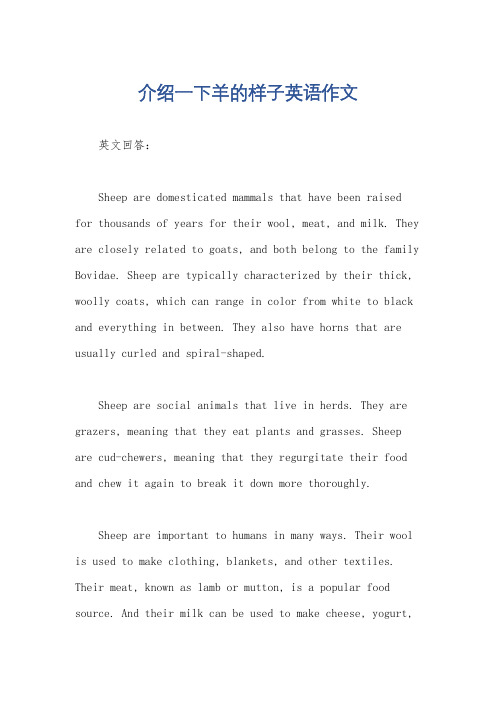
介绍一下羊的样子英语作文英文回答:Sheep are domesticated mammals that have been raisedfor thousands of years for their wool, meat, and milk. They are closely related to goats, and both belong to the family Bovidae. Sheep are typically characterized by their thick, woolly coats, which can range in color from white to black and everything in between. They also have horns that are usually curled and spiral-shaped.Sheep are social animals that live in herds. They are grazers, meaning that they eat plants and grasses. Sheep are cud-chewers, meaning that they regurgitate their food and chew it again to break it down more thoroughly.Sheep are important to humans in many ways. Their wool is used to make clothing, blankets, and other textiles. Their meat, known as lamb or mutton, is a popular food source. And their milk can be used to make cheese, yogurt,and other dairy products.中文回答:羊的外貌。
哺乳动物介绍 英文上课讲义

哺乳动物介绍英文Hello everyone! Today our group is going to give a presentation about mammals. As one of species evolves from late Jurassic period(侏罗纪晚期), mammalians’brains are more developed and specialized than any other class of animals. Mammals are characterized by mammary glands(乳腺) that are modified for producing milk. All mammals have special sweat glands(汗腺) and hair.Here are five mammals we want to share with you:The first of are pandas. Panda is one of the most precious animals in the world. With white and black color, these animals are very fluffy and a little clumsy. Known as Chinese treasures, panda is a kind of animal that is endemic to China, they’re living in Sichuan province. Bamboo is their favorite food. Because of its cute appearance, panda is deep loved by the world public. 1961, WWF established its mark on the giant panda, the panda has become a symbol of the most important species conservation, also as a goodwill important representatives in the diplomatic activities in China.The second one is polar bear, the largest terrestrial carnivorous animal. The polar bear is a bear native largely within the Arctic Circle encompassing(围绕) the Arctic Ocean, its surrounding seas and surrounding land messes. It is the world’s largest land carnivore(食肉动物) and also the largest bear. It has thick fat and hair to stay warm, its white appearance on white snow is good protective coloration. It can move both on land and sea, thus it’s an advantage for a polar bear to catch food in such an extremely harsh climate. Nevertheless global warming has impact on the ice nowadays. The ice melts quickly in the two poles, which has a bad influence on polar bears. Their homes has been destroyed, the prey is also in reduction. We must take measures to protect these animals, for they’re in danger, they’re the treasure of nature.The third one is t he Roe Deer(狍子).The program of Dad, Where Are We Going has been very popular among many people, one of the period programs showed that these five pair fathers and children came to the northeast rural, and saw a cute animal——the roe deer, which make much more people aware of it. The roe deer is also called dwarf deer or wild sheep, which are herbivores(食草动物), feed on plants. The fur’s color of roe deer are usually straw yellow,t here is white haired in roe deer’s base of the tail, it looks really funny. In addition, the male roe deer have set of antlers(鹿角), but female roe deer don’t have, this is the way that how to recognize their sexes. The roe deer has very big and bright eyes, which makes it looks socuddly(可爱的). The roe deer almost live in open forest area, sometimes near the river valley. They rest in the forest during the day, take activities in the early morning or the late evening, because they are very timid and sensitive. they will run quickly if they finds you. As we know, there is one saying “Stupid Roe Deer” in the northeast area, it often be used to describe the people who is a little clumsy, and it’s gradually used to praise one person who is pretty and cute. But its own meaning is that the roe deer is so curious. When a hunter is chasing the roe deer, theroe deer will run very fast, but if the hunter stop to run after it, because of its curiosity, the roe deer will run back to the primary place to see what happened, the hunter doesn’t need or use great effort, then he can capture the roe deer very easily. How funny!The next one is Mongoose. Mongooses are primarily found in Africa, their range covering most of the continent. Some species occupy parts of southern Asia and the Iberian Peninsula. They are generally terrestrial mammals, but some are semi-aquatic, and others are at home in the treetops. They normally have brown or gray fur, and a number of species sport striped(有条纹的) coats or ringed tails. Mongooses live inburrows(地洞) , feeding on small animals such as birds, frogs, insects, and worms. Some species supplement their diet with fruits, nuts, and seeds. Creative hunters, they are known to break open bird eggs by throwing them with their forepaws toward a solid object. Today effort has been done to control the number of this animal. As mongooses threaten the survival of various native species, particularly birds. However, in their natural environments, mongooses are currently threatened themselves due to habitat loss.The last one is sloth. Sloths are extremely slow-moving mammals found in the rainforest of Central and South America. There are two species of sloths: two-toed and three-toed. Most sloths are about the size of a small dog and they have short, flat heads. Their hair is grayish brown but, at times they look grey-green in color because they move so slowly that tiny algae grow all over their coats. Some sloths stay in the same tree for years. Their huge hooked claws and long arms allow them to spend most of their time hanging upside-down from trees. Since they have a slow metabolism(新陈代谢), they need very little food. They feed on fruit, leaves, buds, and youngtwigs(细枝). Sloths also sleep upside-down for up to 18 hours at a time. Mothers also give birth to babies upside-down. Babies cling to their mothers until they are able to take care of themselves.That’s all. Thank you!。
介绍一种哺乳动物英语作文

介绍一种哺乳动物英语作文Here is an essay about a mammal in English:Mammals are a diverse group of vertebrate animals that are characterized by the presence of hair, the ability to produce milk to feed their young, and the possession of specialized teeth. One fascinating mammal species is the polar bear (Ursus maritimus). Native to the Arctic region, the polar bear is the largest living land carnivore, with adult males weighing up to 1,500 pounds.Polar bears are well-adapted to the harsh Arctic environment. Their thick, insulating fur coat and a layer of fat beneath the skin help them to retain body heat and survive the frigid temperatures of the Arctic. Their large, partially webbed paws act as snowshoes, allowing them to move easily across the ice and snow. Polar bears are also excellent swimmers, using their front paws to propel themselves through the water in search of their primary prey: seals.Seals make up the majority of a polar bear's diet, with ringed seals (Pusa hispida) and bearded seals (Erignathusbarbatus) being their preferred sources of food. Polar bears will also consume other marine life, such as fish, birds, and even the occasional whale carcass. Their hunting strategy involves waiting patiently at seal breathing holes or seal pupping lairs, or stalking and ambushing seals on the ice.One of the most remarkable adaptations of the polar bear is its ability to go for extended periods without food. During the summer months, when sea ice melts and seals become more difficult to find, polar bears may fast for several weeks or even months. They are able to do this by entering a state of "walking hibernation," where their metabolism slows down, and they conserve energy by resting and moving less.Sadly, the polar bear's future is under threat due to the effects of climate change. As the Arctic region warms and sea ice melts at an alarming rate, polar bears are finding it increasingly difficult to find and catch their seal prey. This has led to a decline in their population, with the International Union for Conservation of Nature (IUCN) listing the polar bear as a "vulnerable" species.Conservation efforts are underway to protect the polar bear and its Arctic habitat. This includes measures to reduce greenhouse gas emissions, establish protected areas, and limit human activities that may disturb or harm polar bears. Additionally, research is being conducted to better understand the impacts of climate change on polar bears and to develop strategies for their long-term survival.In conclusion, the polar bear is a remarkable and captivating mammal that is adapted to the harsh Arctic environment. However, the species is facing significant challenges due to the effects of climate change, and it is crucial that we take action to protect this iconic animal and its fragile ecosystem.现在用中文总结一下:极地熊是一种非常独特的哺乳动物。
英语认识动物和描述动物特征

英语认识动物和描述动物特征Animals are an important part of our world, and learning about them is not only interesting but also beneficial. By understanding animals and their unique characteristics, we can develop a greater appreciation for the diverse species that coexist with us on this planet. In this article, we will explore various animals and describe their distinguishing features.1. MammalsMammals are perhaps the most familiar group of animals to us. They are warm-blooded and have hair or fur covering their bodies. Among them, the lion is an iconic example. Lions belong to the cat family and are known for their majestic appearance. They have a large, muscular body with a tan or sandy-colored coat. Male lions also have a distinctive mane, which is absent in females.2. BirdsBirds are known for their ability to fly, as well as their feathered bodies. One fascinating bird is the peacock. Male peacocks have colorful, elongated feathers that form a vibrant display known as a "peacock tail." The vibrant colors and patterns on their feathers are used to attract females during courtship rituals. Female peacocks, on the other hand, have less extravagant feathers.3. ReptilesReptiles are cold-blooded creatures covered in scales or plates. Crocodiles are one of the most well-known reptiles. They have a long,muscular body with a tough, armored skin. Their snouts are elongated, and their teeth are sharp and interlocking. Crocodiles are remarkable for their ability to swim swiftly and silently in water, making them formidable predators.4. AmphibiansAmphibians are cold-blooded animals that live both on land and in water. Frogs are a familiar example. Frogs have smooth, moist skin and powerful hind legs designed for jumping. They have long tongues, which they use to catch insects as food. Additionally, frogs are known for their distinct croaking sound, especially during mating season.5. FishFish are aquatic creatures with gills and fins. The clownfish is a popular fish known for its vibrant orange color with white stripes. It has a slim, compressed body and is usually small in size. One notable feature of the clownfish is its mutualistic relationship with sea anemones. It seeks protection in the anemone's stinging tentacles while providing nutrients to the anemone through its waste.6. InsectsInsects are the most diverse group of animals on Earth. Among them, butterflies capture our attention with their colorful wings. Butterflies have slender bodies with large, delicate wings covered in scales. These scales give them their vibrant colors and patterns. Butterflies undergo a remarkable transformation called metamorphosis, starting as caterpillars and eventually emerging as beautiful butterflies.7. MollusksMollusks are soft-bodied invertebrate animals that usually have a hard outer shell. The octopus is a fascinating example. Octopuses have a rounded body with eight tentacles, each equipped with suction cups for gripping objects. They are known for their exceptional ability to camouflage and squeeze through small openings due to their flexible bodies.In conclusion, by understanding and describing animal characteristics, we gain a deeper appreciation for the diversity and beauty of the animal kingdom. From the powerful lion to the delicate butterfly, each creature possesses unique features that contribute to the intricate tapestry of life on Earth. Let us continue to explore and learn about the fascinating world of animals.。
介绍一种哺乳动物英语作文
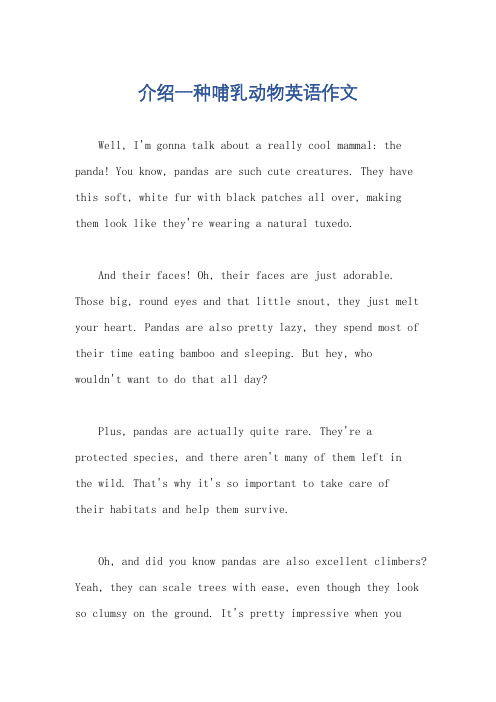
介绍一种哺乳动物英语作文Well, I'm gonna talk about a really cool mammal: the panda! You know, pandas are such cute creatures. They have this soft, white fur with black patches all over, making them look like they're wearing a natural tuxedo.And their faces! Oh, their faces are just adorable. Those big, round eyes and that little snout, they just melt your heart. Pandas are also pretty lazy, they spend most of their time eating bamboo and sleeping. But hey, whowouldn't want to do that all day?Plus, pandas are actually quite rare. They're a protected species, and there aren't many of them left inthe wild. That's why it's so important to take care oftheir habitats and help them survive.Oh, and did you know pandas are also excellent climbers? Yeah, they can scale trees with ease, even though they look so clumsy on the ground. It's pretty impressive when yousee them do it.And last but not least, pandas are a symbol of peace and harmony. They're often used as a diplomatic gift between countries, bringing joy and friendship wherever they go. So, yeah, pandas are not just cute, they're also meaningful and important to our world.。
英语介绍动物特征作文
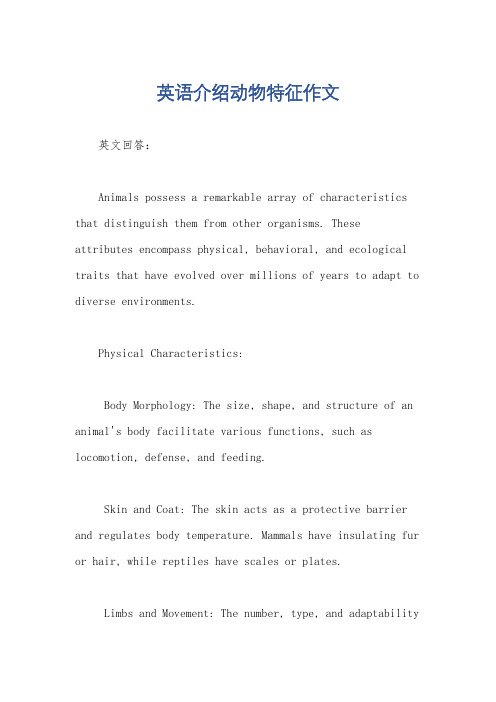
英语介绍动物特征作文英文回答:Animals possess a remarkable array of characteristics that distinguish them from other organisms. Theseattributes encompass physical, behavioral, and ecological traits that have evolved over millions of years to adapt to diverse environments.Physical Characteristics:Body Morphology: The size, shape, and structure of an animal's body facilitate various functions, such as locomotion, defense, and feeding.Skin and Coat: The skin acts as a protective barrier and regulates body temperature. Mammals have insulating fur or hair, while reptiles have scales or plates.Limbs and Movement: The number, type, and adaptabilityof limbs enable animals to navigate their environments. Some have wings for flight, others have fins for swimming, and terrestrial species have specialized legs for walking or running.Sensory Organs: Eyes, ears, and other sensory receptors perceive and respond to external stimuli, providing vital information for survival.Teeth and Digestion: The structure and function of an animal's teeth are closely related to its feeding habits, reflecting its dietary preferences.Behavioral Characteristics:Communication: Animals utilize a wide range of vocalizations, gestures, and chemical signals to interact with others of their species.Social Behavior: Many animals live in social groups that provide benefits for survival, such as protection, cooperation in foraging, and mate selection.Learning and Memory: Animals exhibit varying degrees of cognitive abilities, including the capacity to learn from experience and adapt to changing circumstances.Instincts and Reflexes: Hardwired behaviors serve as inherited responses to specific stimuli and play a pivotal role in animal survival.Reproduction: The methods and patterns of reproduction influence population dynamics and genetic diversity.Ecological Characteristics:Habitat: Animals occupy specific ecological niches within their environments, which provide them with the necessary resources for survival.Diet: Animals have evolved specialized diets toexploit different food sources, contributing to food chains and nutrient cycling.Interspecific Interactions: Animals interact withother species in their ecosystems, including competition, predation, and mutualism.Adaptations: Over time, animals have developed unique adaptations to survive in specific habitats. These adaptations can range from camouflage to venom production.Ecosystem Services: Animals play a vital role in maintaining ecosystem health by pollinating plants, dispersing seeds, and regulating populations.中文回答:动物特征。
熊猫的特征和外貌描写英语作文
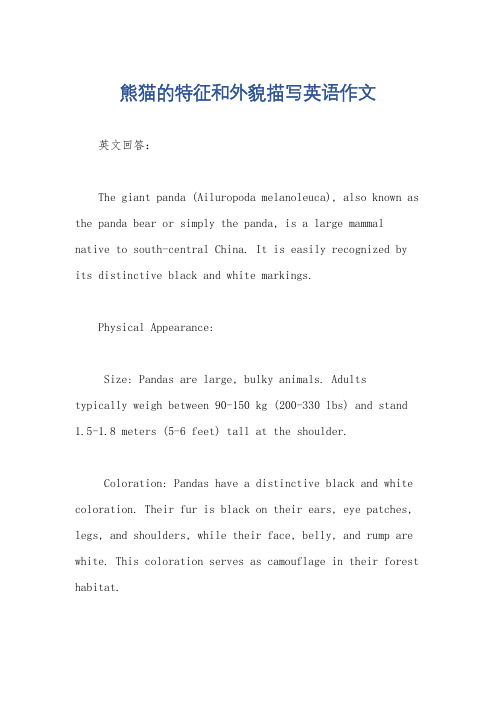
熊猫的特征和外貌描写英语作文英文回答:The giant panda (Ailuropoda melanoleuca), also known as the panda bear or simply the panda, is a large mammal native to south-central China. It is easily recognized by its distinctive black and white markings.Physical Appearance:Size: Pandas are large, bulky animals. Adultstypically weigh between 90-150 kg (200-330 lbs) and stand 1.5-1.8 meters (5-6 feet) tall at the shoulder.Coloration: Pandas have a distinctive black and white coloration. Their fur is black on their ears, eye patches, legs, and shoulders, while their face, belly, and rump are white. This coloration serves as camouflage in their forest habitat.Head: Pandas have a large, round head with short, rounded ears. Their eyes are small and black, with prominent dark circles underneath.Teeth: Pandas have powerful jaws and large molars adapted for crushing bamboo, their primary food source. They also have elongated canine teeth for defense.Tail: Pandas have a short, fluffy tail that is typically 10-15 centimeters (4-6 inches) long.Feet: Pandas have large, padded feet with sharp claws. Their hind feet are slightly larger than their front feet and are used for climbing trees.Scent glands: Pandas possess scent glands on their chest, abdomen, and feet, which they use for communication and marking territory.Other Characteristics:Behavior: Pandas are generally solitary animals exceptduring the breeding season. They spend most of their time sleeping, eating, or climbing trees.Diet: Pandas are herbivores and almost exclusivelyfeed on bamboo. They consume large quantities of bamboo shoots, leaves, and stems, which provide them with the necessary nutrients.Habitat: Pandas live in temperate forests in the mountains of central China. They prefer areas with abundant bamboo forests and dense vegetation.Conservation status: Giant pandas are an endangered species due to habitat loss, fragmentation, and poaching. Conservation efforts are underway to protect their population and preserve their habitat.中文回答:熊猫的特征和外貌描写。
虎鲸特征英文介绍作文

虎鲸特征英文介绍作文英文:The killer whale, also known as the orca, is a highly intelligent and social marine mammal. They are easily recognizable by their distinctive black and white coloring and their large dorsal fin. Killer whales are found in all oceans, from the Arctic to the Antarctic, and they are known to travel in pods, or groups, of up to 40 individuals.One of the most remarkable features of killer whales is their sophisticated communication system. They use avariety of clicks, whistles, and pulsed calls to communicate with each other and coordinate their hunting efforts. This advanced communication system allows them to work together to hunt and capture prey, making them one of the most successful predators in the ocean.Killer whales are also known for their complex social structure and strong family bonds. They live in matrilinealgroups, which are led by the oldest female in the pod. The younger whales learn from their elders and rely on their knowledge and experience to survive in the wild. This close-knit family structure ensures the survival and success of the pod as a whole.In addition to their intelligence and social skills, killer whales are also powerful and agile swimmers. They are capable of reaching speeds of up to 34 miles per hour and can leap completely out of the water, a behavior known as breaching. This impressive athleticism allows them to hunt a wide variety of prey, including fish, seals, and even other whales.Overall, the killer whale is a fascinating and awe-inspiring creature, with a range of unique features that set it apart from other marine mammals.中文:虎鲸,也被称为逆戟鲸,是一种高度智能和社会性的海洋哺乳动物。
兔子各种特点介绍英文作文
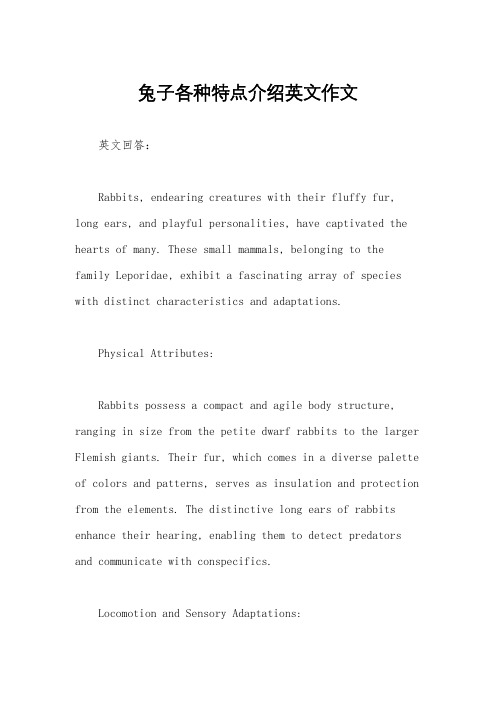
兔子各种特点介绍英文作文英文回答:Rabbits, endearing creatures with their fluffy fur, long ears, and playful personalities, have captivated the hearts of many. These small mammals, belonging to thefamily Leporidae, exhibit a fascinating array of species with distinct characteristics and adaptations.Physical Attributes:Rabbits possess a compact and agile body structure, ranging in size from the petite dwarf rabbits to the larger Flemish giants. Their fur, which comes in a diverse palette of colors and patterns, serves as insulation and protection from the elements. The distinctive long ears of rabbits enhance their hearing, enabling them to detect predators and communicate with conspecifics.Locomotion and Sensory Adaptations:Rabbits are renowned for their exceptional hopping motion, made possible by their powerful hind legs. Their keen eyesight allows them to navigate their environment with ease, while their acute sense of smell and hearing aid in detecting danger and locating food sources. The presence of vibrissae, or whiskers, on their face and around their mouth enhances their tactile perception.Behavioral Traits:Rabbits exhibit a social hierarchy within their colonies, with dominant individuals asserting their status through displays of aggression and grooming. They are crepuscular, meaning they are most active during dawn and dusk. These herbivores primarily feed on grasses and vegetation, and their distinctive digestive system involves a process called caecotrophy, where they ingest their own droppings to extract additional nutrients.Reproduction and Offspring:Rabbits reach sexual maturity at a young age and can reproduce rapidly. Females give birth to litters of up to 12 kits, which are born altricial and depend heavily on their mother for care. Rabbits exhibit a high level of parental investment, with both the male and female participating in protecting and nourishing their young.Domestication and Uses:Rabbits have a long history of domestication, dating back to ancient times. They have been used for a variety of purposes, including as pets, sources of food and fur, and even in scientific research. Today, rabbits are popular companion animals, known for their affectionate and playful nature.Conservation Status:Certain species of rabbits face conservation concerns due to habitat loss, hunting, and introduction of invasive species. Efforts are underway to protect and preserve these populations, ensuring the survival of these charismaticcreatures.中文回答:兔子各种特点介绍。
介绍猪是哺乳动物作文英文

介绍猪是哺乳动物作文英文Pigs, belonging to the Suidae family, are fascinating mammals with a rich history of interaction with humans. As mammals, they share many characteristics with other members of their taxonomic class, including being warm-blooded, having mammary glands to nurse their young, and givingbirth to live offspring. In this essay, we will delve into the world of pigs, exploring their biology, behavior, and significance to humans.Firstly, let's discuss the biology of pigs. Pigs are characterized by their stout bodies, short legs, and snouts. They are omnivorous animals, meaning they consume bothplant matter and meat. Their diet often includes grains, fruits, vegetables, and occasionally small animals. Pigs have a well-developed sense of smell, which they use for foraging and detecting food. This keen sense of smell is facilitated by their large, mobile snouts.Reproductive physiology is another fascinating aspectof pig biology. Female pigs, known as sows, typically give birth to litters of piglets after a gestation period of around three months, or 114 days. Piglets are bornrelatively immature and require care from their mother to survive. Sows are known for their strong maternal instincts and will fiercely protect their offspring.In terms of behavior, pigs are highly social animals that form complex social structures within their groups. They communicate through a variety of vocalizations, body language, and scent marking. Pigs are also known for their intelligence, ranking among the most intelligent domesticated animals. They have excellent memories and are capable of learning and adapting to various environments.The relationship between pigs and humans dates back thousands of years. Domestication of pigs likely began around 9,000 years ago in the Near East, where they were valued for their meat, fat, and ability to forage for food. Pigs have since become an integral part of many cultures around the world, providing sustenance, labor, and companionship to humans.In addition to their role as a food source, pigs have also contributed to scientific research and medical advancements. Their physiological similarities to humans make them valuable subjects for studying various diseases and conditions. Pigs have been used in research related to organ transplantation, cardiovascular health, and reproductive biology, among other areas.In conclusion, pigs are remarkable creatures with a diverse range of biological, behavioral, and cultural significance. As mammals, they share many traits with humans and other members of their taxonomic class. From their biology and behavior to their role in human society, pigs continue to captivate and intrigue us in countless ways.。
- 1、下载文档前请自行甄别文档内容的完整性,平台不提供额外的编辑、内容补充、找答案等附加服务。
- 2、"仅部分预览"的文档,不可在线预览部分如存在完整性等问题,可反馈申请退款(可完整预览的文档不适用该条件!)。
- 3、如文档侵犯您的权益,请联系客服反馈,我们会尽快为您处理(人工客服工作时间:9:00-18:30)。
Internal Transport
• Blood flows through a double loop circulatory system and a four chambered heart. The chambers are 2 atria and 2 ventricles.
Feeding…
• Those mammals that eat plant material will have a longer digestive tract compared to meat eaters. • They also have a rumen, which is an area to store plant material and wait to begin the digestive process (read top paragraph, page 741 elephant book)
Feeding…
• Some mammals have the cecum which is similar to the rumen but found by the intestines.
Respiration
• Mammals require a constant supply of oxygen. • Mammals have two adaptations that increase the efficiency of the lungs: the diaphragm and air sacs. • Diaphragm is a dome shaped sheet of muscle, it pulls air into the lungs by expanding the chest cavity. • Air sacs increase area for oxygen to be exchanged. • Many mammals are able to exhale air to vibrate vocal cords and produce a variety of sounds.
Mammal Characteristics
mammal?
• Belong to the class Mammalia • Endothermic vertebrate with hair • Females have mammary glands, secrete milk to feed young • There are approximately 4500 species of mammals.
Movement
• Slowest-two toes sloth-active only four hours a day. • Fastest-cheetah 400 m per 15 sec, humans 150 m per 15 sec • How do they run?
– Long legs – Flexible hip and shoulder joints
Feeding
• Endotherms require a lot of energy. • Mammals eat different types of food so they need specialized teeth. • Specialized teeth (page 649)
– Incisors—gripping and cutting – Canines—piercing and tearing – Premolars and molars—grinding and crushing
– Cerebrum--largest part -thinking and learning goes on here. – Cerebellum--controls movements. – Medulla--controls body functions such as breathing and heart rate.
Response…
• When in danger mammals will.. – Run quickly – Use horns and hooves to strike – Work in herds or a pack
Response…
• Some have good smell—dogs, cheetah, other meat eaters • Some have good hearing, high frequency sound waves—dogs and bats • Most have good eyesight, several cannot see color. Underground mammals have poor vision but good touch and smell
Movement…
• Other forms of movement seen in mammals
– Climbing—monkeys use the tail as well – Swimming—paddles/flippers – Flying--bats
Response
• Mammals have the most developed brain in the animal kingdom. • There are three parts to the brain:
Size of mammals
• Mammals vary in size
– Smallest—pygmy shrew—must eat constantly – Largest—blue whale—weighs as much as 32 elephants
• Mammals live in most types of environment. Their hair, sweat glands and fat varies depending on where they live.
